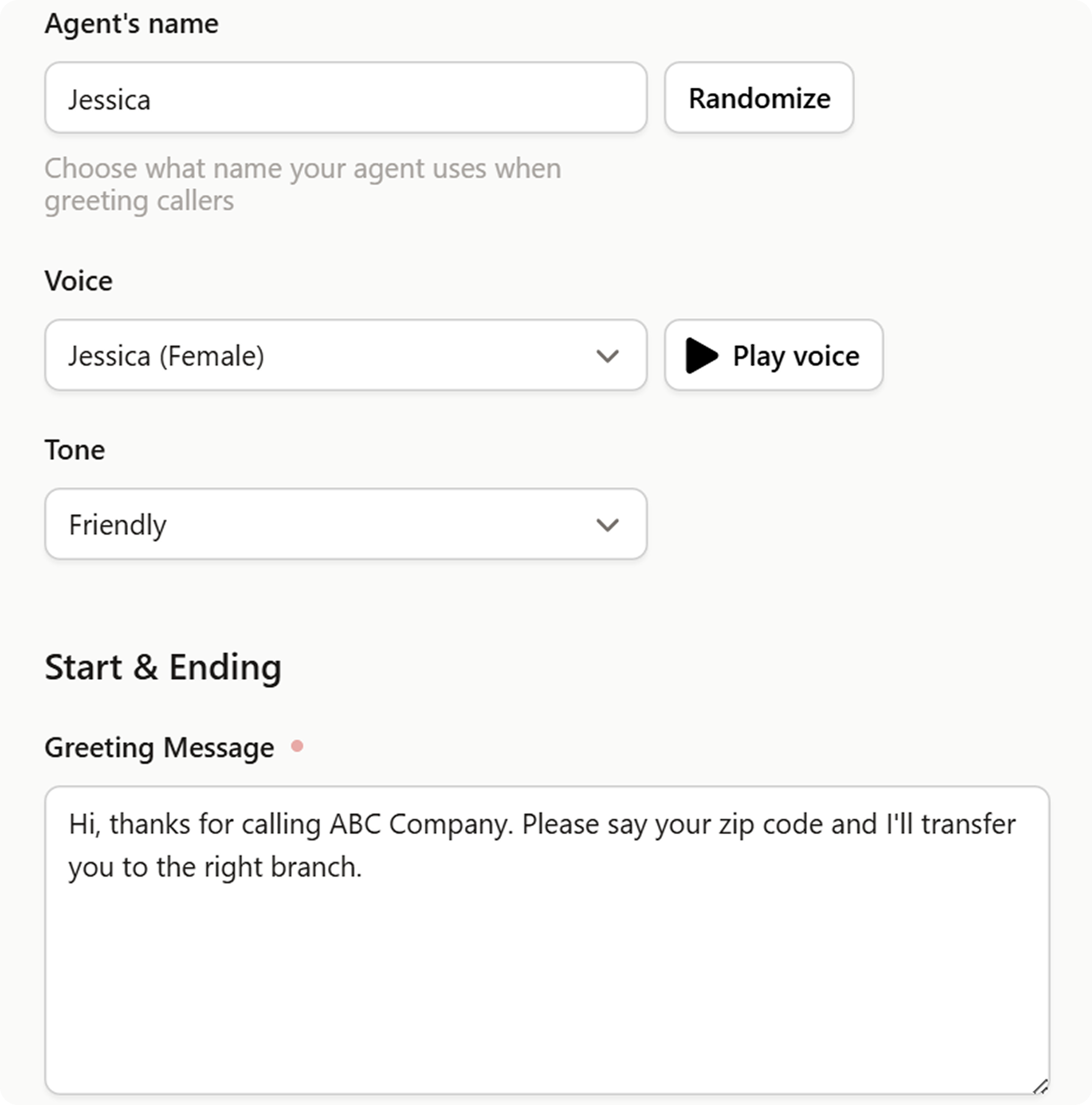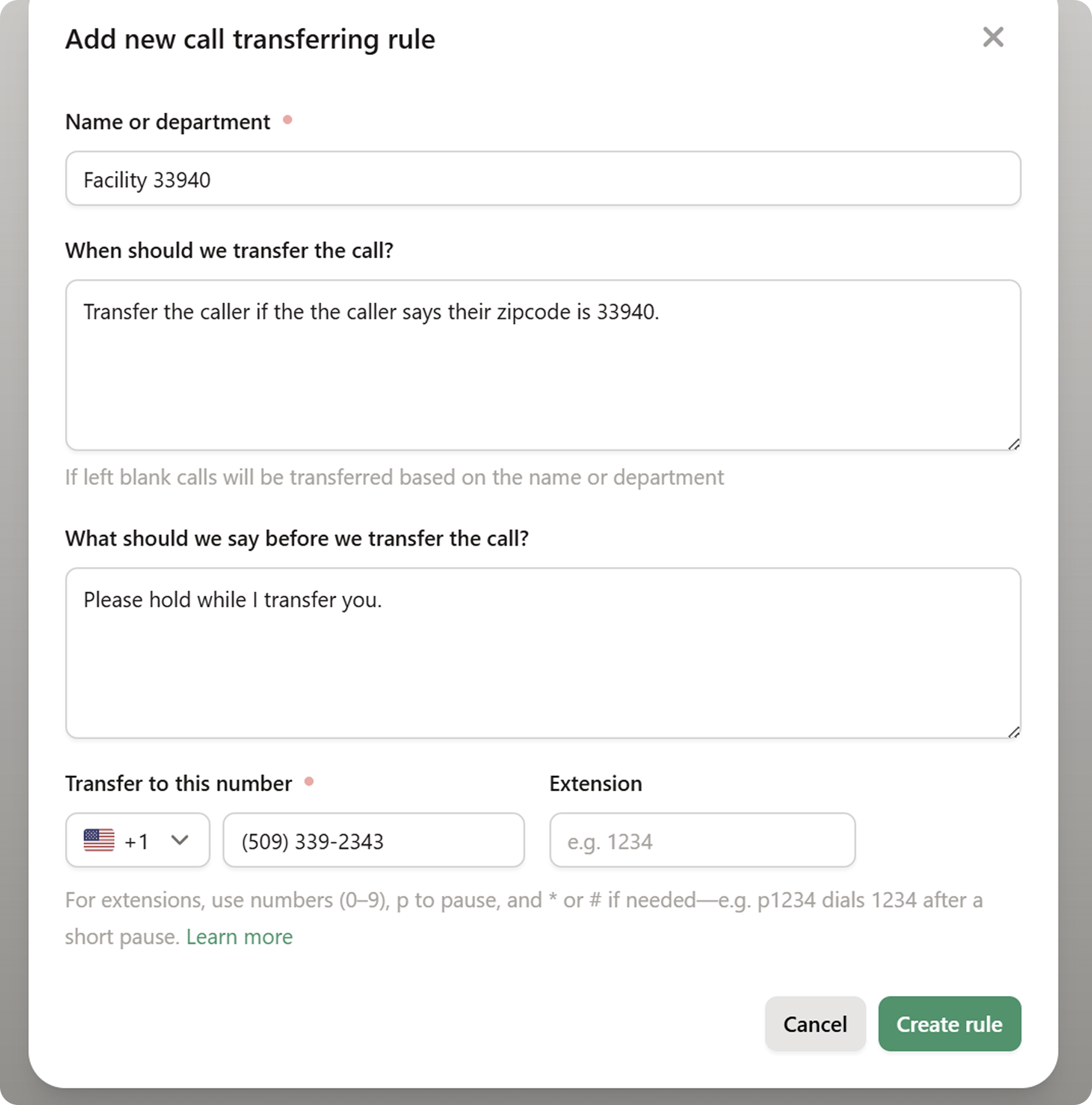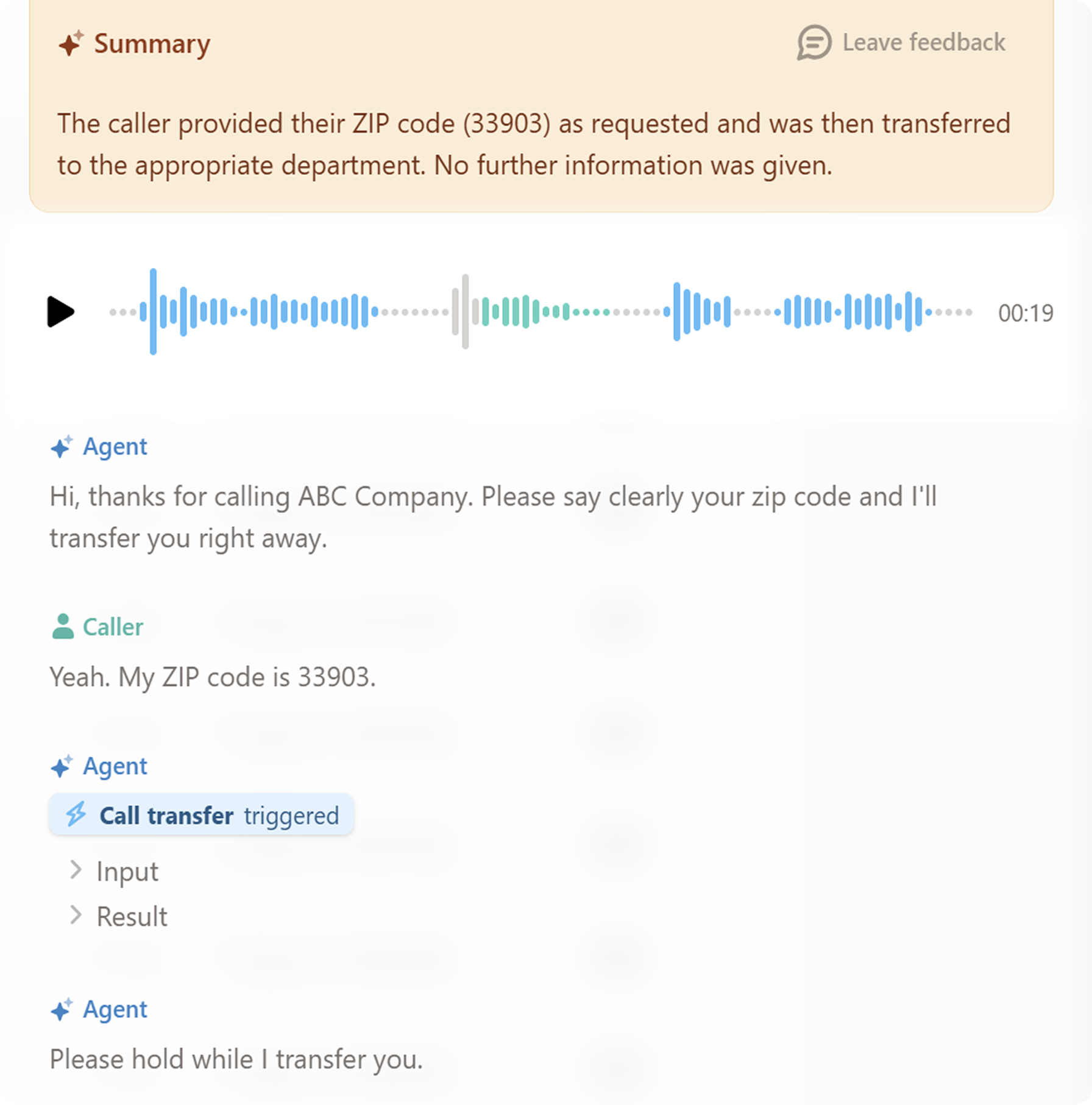- Los agentes de voz de IA pueden dirigir las llamadas a la ubicación correcta mediante los códigos postales de las personas que llaman, lo que garantiza que los clientes lleguen siempre a la sucursal correcta.
- Esta tecnología ofrece un enrutamiento de llamadas más rápido, confiable y asequible que los menús telefónicos tradicionales o los recepcionistas en vivo, lo que es perfecto para empresas con varias ubicaciones.
- Upfirst facilita la configuración y personalización del enrutamiento por código postal, con respuestas ininterrumpidas, reglas flexibles e integración con su número de teléfono actual.
Si su empresa tiene más de una sucursal, sabe lo difícil que puede ser hacer que las personas que llaman a la sucursal correcta en el primer intento. Muchos clientes simplemente llaman al número principal con la esperanza de que alguien pueda enviarlos en la dirección correcta. Ahí es donde un Agente de voz con IA que gestiona el enrutamiento de llamadas entre varios centros según el código postal de la persona que llama puede marcar una gran diferencia.
Con esta solución inteligente, cada llamada es respondida por un asistente automático que solicita el código postal de la persona que llama y luego la dirige a la ubicación correcta, sin tener que hacer conjeturas ni hacer transferencias manuales. Ya sea que quieras dirigirte a la sucursal más cercana, a un área de servicio específica o a las reglas de cobertura, esta tecnología simplifica las cosas tanto para las personas que llaman como para el personal.
En este artículo, analizaremos cómo funciona la captura de códigos postales por teléfono con un agente de voz de IA y cómo puedes empezar hoy mismo.
¿Qué es un agente de voz de IA para el enrutamiento de llamadas por código postal?
Un agente de voz de IA para el enrutamiento de llamadas basado en ZIP es un sistema automático de contestador telefónico que saluda a las personas que llaman, les pide su código postal y luego las conecta con la ubicación correcta. El sistema puede entender los códigos postales hablados e incluso trabajar con códigos ZIP+4 ampliados. Una vez que se captura el código, comprueba una tabla de enrutamiento, un mapa o un conjunto de reglas de enrutamiento de llamadas para encontrar la mejor combinación.
Para asegurarte de que la información es correcta, puedes dar instrucciones a tu IA servicio de recepcionista virtual para repetir los dígitos para confirmarlo y vuelve a preguntar si no está seguro. Tras la validación, el agente de voz basado en la IA conecta la llamada con la sucursal, el territorio o el equipo de guardia correctos de acuerdo con tus reglas de enrutamiento de llamadas.
Este es un paso adelante con respecto a los menús de teléfono tradicionales que solo ofrecen opciones fijas como «pulsar 1 para vender». Y aunque los recepcionistas en vivo pueden hacer este trabajo, tienen que buscar cada código postal manualmente. Un agente de voz con IA lo hace de forma instantánea y precisa en todo momento.
Cómo funciona la captura y validación de códigos postales por teléfono
La llamada comienza con un saludo amistoso y luego solicita un código postal de 5 dígitos. El agente escucha los números y comprueba que los datos ingresados coincidan con los códigos postales válidos en las reglas de transferencia de llamadas.
Si la IA no está segura de haber escuchado el ZIP correctamente, repite los dígitos: «Escuché 30306. ¿Es correcto?» y permite que la persona que llama confirme. De lo contrario, guía a la persona que llama para que vuelva a intentarlo, un dígito a la vez si es necesario.
Por qué el enrutamiento ZIP basado en inteligencia artificial es ideal para empresas con múltiples ubicaciones
El uso de la IA para enrutar las llamadas por código postal les facilita la vida a usted y a sus clientes. Así es como ayuda:
- Siempre disponible: La IA responde a todas las llamadas, las 24 horas del día, los 7 días de la semana, y utiliza el mismo enrutamiento inteligente sin importar la hora del día.
- Conexiones rápidas: Las llamadas se contestan al instante, se captura el código postal y se dirigen al lugar correcto, sin esperas ni transferencias manuales.
- Experiencia confiable: Todas las personas que llaman reciben el mismo saludo, indicaciones claras y un enrutamiento preciso, para que nadie se pierda en el lío.
¿Fuera del horario laboral? El sistema puede reproducir mensajes personalizados, reservar citas o reenviar llamadas urgentes al personal de guardia. Esto reduce los tiempos de espera, las conexiones incorrectas y las oportunidades perdidas.
Comparación del enrutamiento de códigos postales con otras opciones de enrutamiento de llamadas
Hay varias maneras en las que las empresas pueden distribuir las llamadas entre ubicaciones:
- Enrutamiento basado en zip: Utiliza el código postal de la persona que llama para una coincidencia precisa de la ubicación.
- Enrutamiento del identificador de llamadas: Intenta adivinar la ubicación por código de área, pero los números móviles suelen hacer que sea inexacto.
- IVR basado en menús: Ofrece opciones como «presiona 1 para ir a Main Street», pero los menús largos pueden confundir a las personas que llaman.
- Enrutamiento por turnos o simultáneo: Distribuye las llamadas de manera uniforme, pero ignora dónde se encuentra realmente la persona que llama.
El enrutamiento basado en zip es el más preciso y fácil de usar cuando quieres que la gente vaya a la sucursal correcta en todo momento.
Comparación de costos: los agentes de voz de IA frente a los servicios de respuesta tradicionales
Los agentes de voz de IA suelen ser mucho más asequibles. La mayoría de los planes incluyen una cuota mensual baja más un pequeño cargo por minuto o por llamada (normalmente entre 0,03 y 0,20 USD por minuto o entre 0,75 y 1,50 USD por llamada). Por el contrario, los servicios de contestador tradicionales pueden cobrar entre 200 y 400 dólares al mes como base, más entre 0,80 y 1,50 dólares por minuto, especialmente fuera del horario de atención.
Upfirst: enrutamiento de códigos postales fácil y asequible para pequeñas empresas
Primero ofrece un servicio de respuesta basado en inteligencia artificial diseñado para empresas pequeñas y en crecimiento con múltiples ubicaciones. Puedes reenviar tu número actual a UpFirst, sin necesidad de cambiar de compañía telefónica ni comprar teléfonos nuevos.
Comenzar es sencillo: introduce los detalles de tu empresa, indica tus ubicaciones y horarios y sube tu tabla de direcciones postales en las reglas de transferencia de llamadas. Puedes personalizar las instrucciones, las reglas de confirmación y la forma en que el sistema gestiona los ZIP no mapeados.
Durante cada llamada, Upfirst solicita un código postal de 5 dígitos, lo confirma y dirige a la persona que llama según sus preferencias. Si el código postal no está mapeado, el sistema puede encontrar la sucursal más cercana o enviar la llamada a tu línea principal.
Recibirás resúmenes y transcripciones por correo electrónico de cada llamada. Los precios comienzan en 24,95$ al mes para una respuesta profesional las 24 horas del día, los 7 días de la semana, y puedes pruébalo gratis para ver cómo se adapta a su negocio.
Cómo configurar el enrutamiento por código postal con Upfirst
Configurar el enrutamiento de llamadas por código postal es bastante sencillo con Upfirst. Aquí tienes un tutorial sobre cómo puedes configurarlo en cuestión de minutos:
1. Personaliza la voz y el saludo de tu IA

Puedes personalizar tu agente de voz de IA como quieras (e incluso configurarlo para responder a las preguntas frecuentes, programar citas o recopilar información). Pero en este caso, introduzco el saludo anterior para un enfoque más simplificado. El objetivo aquí es transferir a la persona que llama a la ubicación correcta lo más rápido posible.
2. Configure sus reglas para el enrutamiento de llamadas por código postal

Ir a Agente > Transferencias de llamadas para configurar las reglas de enrutamiento de llamadas. Puede configurar tantas como necesite. Asigne un nombre a la regla, como el número o la ubicación de la tienda o establecimiento, y dé instrucciones a la recepcionista sobre cuando la llamada debe transferirse a esa ubicación.
Por ejemplo, «Transfiere a la persona que llama si la persona que llama dice que su código postal es 33903».
A continuación, introduce el mensaje de transferencia (lo que el agente de voz de IA le dice a la persona que llama justo antes de la transferencia). Introduce el número de teléfono de la ubicación a la que quieres hacer la transferencia y haz clic en «Crear regla».
Repite este proceso y crea reglas de transferencia para cada ubicación a la que quieras hacer la transferencia. También puedes agrupar los códigos postales en una sola regla de transferencia si todos comparten la misma ubicación.
3. Haga algunas llamadas de prueba para asegurarse de que funciona sin problemas

Con tu teléfono, haz algunas llamadas de prueba a tu agente de voz de IA y comprueba que la transferencia de llamadas funciona como debería en cada ubicación. Recibe actualizaciones de cada llamada por SMS o correo electrónico para saber en todo momento cuándo llaman las personas. Si tienes algún problema, no dudes en ponerte en contacto con el servicio de asistencia de Upfirst. Siempre estamos dispuestos a echar una mano.
4. Transfiera sus llamadas al número de teléfono de su agente
Cuando estés satisfecho con la configuración, reenvía las llamadas a tu agente de voz de Upfirst para empezar. A partir de ese momento, su recepcionista virtual responderá a cada persona que llame y la dirigirá de acuerdo con sus reglas de enrutamiento de llamadas.
Personalizaciones adicionales:
Su agente de voz de IA con Upfirst se puede personalizar exactamente como lo desee para su negocio. Si prefieres que transfiera la llamada según el código postal de inmediato, puedes seguir un ejemplo similar al anterior.
Sin embargo, si también quieres responder a las preguntas, recopila la información de la persona que llama (por ejemplo, servicio de captura de clientes potenciales), o incluso programar citas, también puedes hacerlo. Incluso podrías reducir la necesidad de transferir llamadas, lo que liberaría más tiempo para tu equipo.
Preguntas frecuentes sobre los agentes de voz de IA para el enrutamiento de llamadas por código postal
¿Con qué frecuencia debo actualizar mi mapa de códigos postales?
Lo mejor es una actualización mensual, especialmente porque el USPS a veces agrega o cambia los códigos postales. Muchos sistemas pueden automatizar estas actualizaciones por ti.
¿El sistema puede enviar los códigos postales y la información de enrutamiento de las personas que llaman a mi CRM?
¡Sí! ¡Moderno! Servicios de respuesta con IA puede pasar el código postal, el número de teléfono y la ruta de enrutamiento de la persona que llama a tu CRM para que tu equipo tenga toda la información que necesita para responder a la llamada.
¿Qué pasa si la persona que llama no da su código postal?
Si alguien no quiere compartir su código postal, el sistema puede enviarlo a una línea principal o a un operador en vivo. Siempre hay una opción de copia de seguridad humana si es necesario.
¿Funcionará el enrutamiento por código postal para los usuarios de teléfonos móviles?
Absolutamente. El enrutamiento basado en ZIP es más confiable que el uso de códigos de área, especialmente porque muchas personas guardan los números de teléfonos celulares de los lugares en los que ya no viven. Al pedir el código postal actual, las personas que llaman siempre llegan al lugar correcto.
Nick Lau is a copywriter and content lead for Upfirst.ai. A self-starter at heart, he dove into marketing in 2015 by launching an e-commerce company, selling private-labeled products on Amazon and Shopify. When he’s not crafting copy, you might spot him on a winding road trip to the coasts or through forests, in search of unexplored places.





.png)


